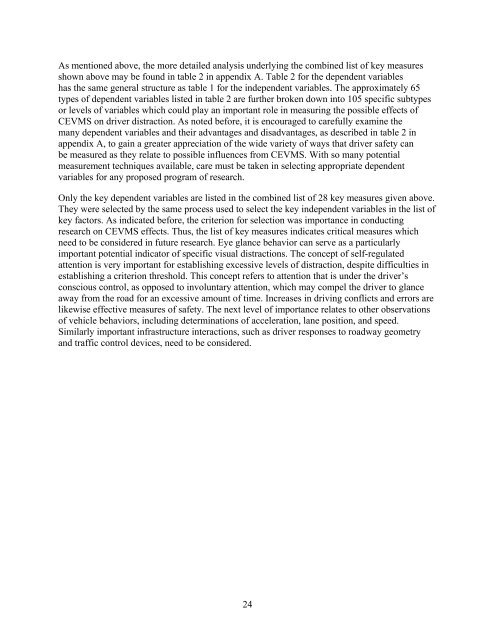The Effects of Commercial Electronic Variable Message Signs ...
The Effects of Commercial Electronic Variable Message Signs ...
The Effects of Commercial Electronic Variable Message Signs ...
You also want an ePaper? Increase the reach of your titles
YUMPU automatically turns print PDFs into web optimized ePapers that Google loves.
As mentioned above, the more detailed analysis underlying the combined list <strong>of</strong> key measures<br />
shown above may be found in table 2 in appendix A. Table 2 for the dependent variables<br />
has the same general structure as table 1 for the independent variables. <strong>The</strong> approximately 65<br />
types <strong>of</strong> dependent variables listed in table 2 are further broken down into 105 specific subtypes<br />
or levels <strong>of</strong> variables which could play an important role in measuring the possible effects <strong>of</strong><br />
CEVMS on driver distraction. As noted before, it is encouraged to carefully examine the<br />
many dependent variables and their advantages and disadvantages, as described in table 2 in<br />
appendix A, to gain a greater appreciation <strong>of</strong> the wide variety <strong>of</strong> ways that driver safety can<br />
be measured as they relate to possible influences from CEVMS. With so many potential<br />
measurement techniques available, care must be taken in selecting appropriate dependent<br />
variables for any proposed program <strong>of</strong> research.<br />
Only the key dependent variables are listed in the combined list <strong>of</strong> 28 key measures given above.<br />
<strong>The</strong>y were selected by the same process used to select the key independent variables in the list <strong>of</strong><br />
key factors. As indicated before, the criterion for selection was importance in conducting<br />
research on CEVMS effects. Thus, the list <strong>of</strong> key measures indicates critical measures which<br />
need to be considered in future research. Eye glance behavior can serve as a particularly<br />
important potential indicator <strong>of</strong> specific visual distractions. <strong>The</strong> concept <strong>of</strong> self-regulated<br />
attention is very important for establishing excessive levels <strong>of</strong> distraction, despite difficulties in<br />
establishing a criterion threshold. This concept refers to attention that is under the driver’s<br />
conscious control, as opposed to involuntary attention, which may compel the driver to glance<br />
away from the road for an excessive amount <strong>of</strong> time. Increases in driving conflicts and errors are<br />
likewise effective measures <strong>of</strong> safety. <strong>The</strong> next level <strong>of</strong> importance relates to other observations<br />
<strong>of</strong> vehicle behaviors, including determinations <strong>of</strong> acceleration, lane position, and speed.<br />
Similarly important infrastructure interactions, such as driver responses to roadway geometry<br />
and traffic control devices, need to be considered.<br />
24

















